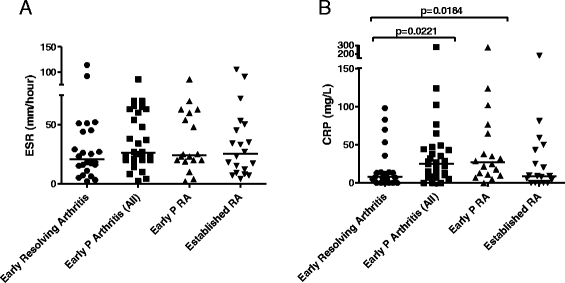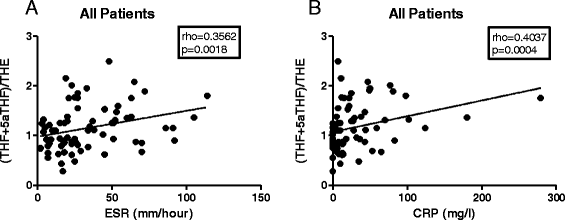Differential glucocorticoid metabolism in patients with persistent versus resolving inflammatory arthritis
- PMID: 25971255
- PMCID: PMC4431033
- DOI: 10.1186/s13075-015-0633-2
Differential glucocorticoid metabolism in patients with persistent versus resolving inflammatory arthritis
Abstract
Introduction: Impairment in the ability of the inflamed synovium to generate cortisol has been proposed to be a factor in the persistence and severity of inflammatory arthritis. In the inflamed synovium, cortisol is generated from cortisone by the 11β-hydroxysteroid dehydrogenase type 1 (11β-HSD1) enzyme. The objective of this study was to determine the role of endogenous glucocorticoid metabolism in the development of persistent inflammatory arthritis.
Methods: Urine samples were collected from patients with early arthritis (symptoms ≤12 weeks duration) whose final diagnostic outcomes were established after clinical follow-up and from patients with established rheumatoid arthritis (RA). All patients were free of disease-modifying anti-rheumatic drugs at the time of sample collection. Systemic measures of glucocorticoid metabolism were assessed in the urine samples by gas chromatography/mass spectrometry. Clinical data including CRP and ESR were also collected at baseline.
Results: Systemic measures of 11β-HSD1 activity were significantly higher in patients with early arthritis whose disease went on to persist, and also in the subgroup of patients with persistent disease who developed RA, when compared with patients whose synovitis resolved over time. We observed a significant positive correlation between systemic 11β-HSD1 activity and ESR/CRP in patients with established RA but not in any of the early arthritis patients group.
Conclusions: The present study demonstrates that patients with a new onset of synovitis whose disease subsequently resolved had significantly lower levels of systemic 11β-HSD1 activity when compared with patients whose synovitis developed into RA or other forms of persistent arthritis. Low absolute levels of 11β-HSD1 activity do not therefore appear to be a major contributor to the development of RA and it is possible that a high total body 11β-HSD1 activity during early arthritis may reduce the probability of disease resolution.
Figures





References
-
- Panayi GS. Hormonal control of rheumatoid inflammation. Br Med Bull. 1995;51:462–71. - PubMed
-
- Verstappen SMM, McCoy MJ, Roberts C, Dale NE, Hassell AB, Symmons DPM. Beneficial effects of a 3-week course of intramuscular glucocorticoid injections in patients with very early inflammatory polyarthritis: results of the STIVEA trial. Ann Rheum Dis. 2010;69:503–9. doi: 10.1136/ard.2009.119149. - DOI - PubMed
Publication types
MeSH terms
Substances
Grants and funding
LinkOut - more resources
Full Text Sources
Other Literature Sources
Medical
Research Materials
Miscellaneous

